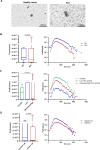Podocyte extracellular vesicles and immune mediators as urinary biomarkers in active lupus nephritis
- PMID: 40764497
- PMCID: PMC12325585
- DOI: 10.1038/s41598-025-08236-3
Podocyte extracellular vesicles and immune mediators as urinary biomarkers in active lupus nephritis
Abstract
Urinary extracellular vesicles (uEVs) and immune mediators have emerged as potential minimally invasive renal biomarkers. Even though active lupus nephritis (LN) is associated with immune complex deposition, tissue inflammation, and podocyte damage, it remains unclear how these parameters are simultaneously altered in systemic lupus erythematosus (SLE). Thus, we aimed to evaluate uEVs as biomarkers in LN, in association with urinary immune mediators. In this cross-sectional study, uEVs were isolated from SLE patients and healthy donors by differential centrifugation and characterized and/or quantified by electron microscopy, nanoscale flow cytometry, and nanoparticle tracking analysis (NTA). Urinary immune mediators were assessed by a multiplex assay. We included 82 patients (42.6 ± 11.3 years-old, 91.4% female), of whom 56.1% (n = 46) had LN, and 18 healthy donors (37.5 ± 8.2 years-old, 83.3% female). No differences were found for particle size/concentration by NTA, but higher counts of total (P = 0.03) and podocyte-derived (P = 0.01) uEVs were observed in SLE patients, especially in active LN (P = 0.02; P = 0.03). We also identified higher urinary levels of cytokines such as IL-6, IL-8, and CCL-2 according to SLE activity and LN (P < 0.05). Significant correlations were observed between uEVs, immune mediators, R-SLEDAI-2K, proteinuria, and albuminuria in active LN. Lastly, the combinatory analysis of podocyte uEVs, IL-6, IFN-γ, IL-8, uCCL-2 and CCL-3 showed a good predictive power to detect active LN (AUC = 0.88, P = 0.0009). Our results suggest that urinary podocyte-derived uEVs and cytokines are associated with LN activity, which may reflect podocyte injury mediated by inflammation. Thus, the combined application of these biomarkers could help to identify patients with podocyte damage and renal inflammation.
Keywords: Extracellular vesicles; Immune mediators; Lupus nephritis; Podocyte; Urine.
© 2025. The Author(s).
Conflict of interest statement
Declarations. Competing interests: The authors declare no competing interests.
Figures



Similar articles
-
Aberrant Glycosylation of IgG in Children With Active Lupus Nephritis Alters Podocyte Metabolism and Causes Podocyte Injury.Arthritis Rheumatol. 2025 Apr 29:10.1002/art.43200. doi: 10.1002/art.43200. Online ahead of print. Arthritis Rheumatol. 2025. PMID: 40297959
-
Extracellular Vesicles Derived From Streptococcus anginosus Aggravate Lupus Nephritis by Triggering TLR2-MyD88-NF-κB Signalling in NK Cells.J Extracell Vesicles. 2025 Jul;14(7):e70134. doi: 10.1002/jev2.70134. J Extracell Vesicles. 2025. PMID: 40673809 Free PMC article.
-
The mechanosensitive ion channel Piezo1 contributes to podocyte cytoskeleton remodeling and development of proteinuria in lupus nephritis.Kidney Int. 2024 Oct;106(4):625-639. doi: 10.1016/j.kint.2024.06.025. Epub 2024 Jul 29. Kidney Int. 2024. PMID: 39084260
-
Systemic treatments for metastatic cutaneous melanoma.Cochrane Database Syst Rev. 2018 Feb 6;2(2):CD011123. doi: 10.1002/14651858.CD011123.pub2. Cochrane Database Syst Rev. 2018. PMID: 29405038 Free PMC article.
-
Systemic pharmacological treatments for chronic plaque psoriasis: a network meta-analysis.Cochrane Database Syst Rev. 2021 Apr 19;4(4):CD011535. doi: 10.1002/14651858.CD011535.pub4. Cochrane Database Syst Rev. 2021. Update in: Cochrane Database Syst Rev. 2022 May 23;5:CD011535. doi: 10.1002/14651858.CD011535.pub5. PMID: 33871055 Free PMC article. Updated.
References
-
- Machida, H. et al. Expression of Toll-like receptor 9 in renal podocytes in childhood-onset active and inactive lupus nephritis. Nephrol. Dial Transpl.10.1093/ndt/gfq058 (2010). - PubMed
MeSH terms
Substances
Grants and funding
- 001/Coordenação de Aperfeiçoamento de Pessoal de Nível Superior
- 001/Coordenação de Aperfeiçoamento de Pessoal de Nível Superior
- 001/Coordenação de Aperfeiçoamento de Pessoal de Nível Superior
- E-26.204.541/2024/Fundação Carlos Chagas Filho de Amparo à Pesquisa do Estado do Rio de Janeiro
- FAPERJ, E-26/211.044/2019/Fundação Carlos Chagas Filho de Amparo à Pesquisa do Estado do Rio de Janeiro
LinkOut - more resources
Full Text Sources

